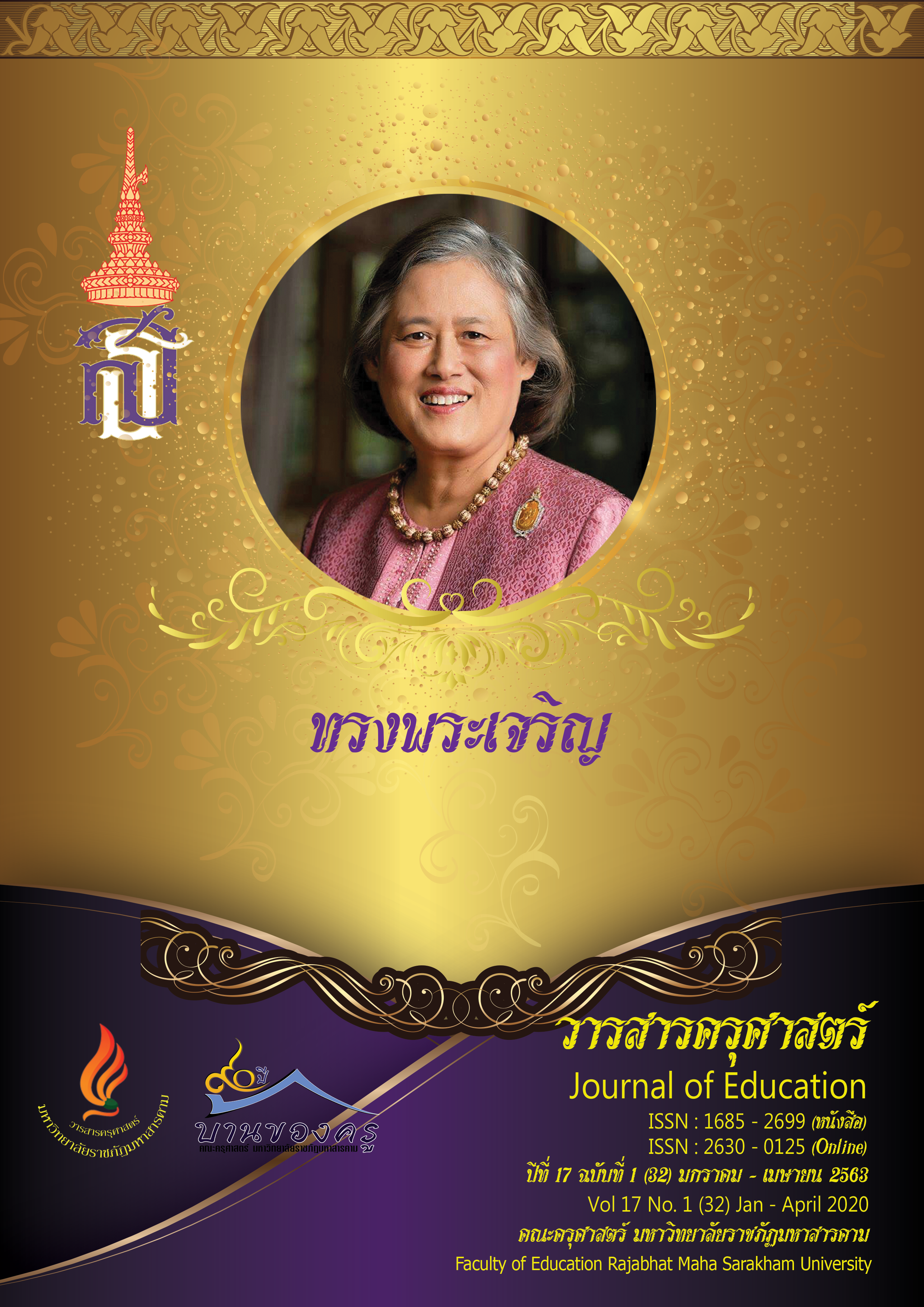Development of Love and Faith in Teaching Profession Scale and Criterion
Main Article Content
Abstract
The purposes of this research were to 1) development of love and faith in teaching
profession scale according to Item Responses Theory, 2) develop a cut score to create a criterion
zone of love and faith in teaching profession score and evaluate a score of love and faith in teaching
profession of educational students. Data were collected from 1,115 students in faculty of Education
from 8 University in Thailand. Research instrument was love and faith in teaching profession scale
with multiple choice in multi-level score. Data were analyzed including estimation 2 parameters of
IRT. The cut-off scores of scales were developed using the criterion zone of the Wright map.
Research findings were as follows: 1) There were 15 question accepted according to IRT
parameter estimation criterion there were only 1 question with differential item function; 2) The
criterion zone of love and faith in teaching profession score consisted 4 level as follows: level 4
faith in teaching profession score ( ) = -0.42 and upper, level 3 love in teaching profession score
between ( ) = -3.25 ถึง -0.41, level 2 good attitude in teaching profession score (
) = -4.95 ถึง -3.24,
and level 1 non- love and faith in teaching profession score ( ) = -4.94 and lower; and 3) There
were 70.40 percent of educational students had love and faith in teaching profession score in level
4 faith in teaching profession, 28.97 percent had love and faith in teaching profession score in level
3 love in teaching profession, and 0.63 percent had love and faith in teaching profession score in
level 2 good attitude in teaching profession.
Article Details
ข้อกำหนดเบื้องต้นที่ผู้นิพนธ์(ผู้ส่งบทความ) ควรทราบ
1. ผู้นิพนธ์ที่ประสงค์จะลงตีพิมพ์บทความกับวารสาร ตั้งแต่เดือนมกราคม 2563 เป็นต้นไป ให้ใช้รูปแบบใหม่ (Template 2563) โดยสามารถดูตัวอย่างได้ที่เมนู GUIDELINES
2. จะตีพิมพ์และเผยแพร่ได้ ต้องผ่านการประเมินจากผู้ทรงคุณวุฒิ (Peer Review)
3. การประเมินบทความโดยผู้ทรงคุณวุฒิ (Peer Review) เป็นแบบ Double Blind
4. การอ้างอิงบทความใช้หลักเกณฑ์ APA (American Psychological Association) คลิก
5. บทความถูกปฏิเสธการตีพิมพ์ ไม่ผ่านการประเมิน ผู้นิพนธ์ขอยกเลิกเองหรือชำระเงินก่อนได้รับการอนุมัติ ทางวารสารไม่มีนโยบายการคืนเงิน
References
ณิชกมล แก่นเพิ่ม และคณะ. (2546). การศึกษาคุณลักษณะความเป็นครูตามความคิดเห็นของนิสิตและบัณฑิตคณะศึกษาศาสตร์ มหาวิทยาลัยเกษตรศาสตร์. การประชุมทางวิชาการของมหาวิทยาลัยเกษตรศาสตร์ครั้งที่ 41 (น. 117-124). มหาวิทยาลัยเกษตรศาสตร์ กรุงเทพมหานคร, ประเทศไทย.
ทัศนา ประสานศรี. (2555). การพัฒนารูปแบบความเป็นครูของนักศึกษา มหาวิทยาลัยนครพนม.วารสารมหาวิทยาลัยนครพนม, 2(3), 25-32.
ไพศาล วรคำ. (2558). การวิจัยทางการศึกษา (พิมพ์ครั้งที่ 8). มหาสารคาม: ตักสิลาการพิมพ์.
เมษา นวลศรี. (2559). การพัฒนาและตรวจสอบโครงสร้างพหุมิติของความเป็นพลเมืองที่มีความรับผิดชอบของนักเรียน ชั้นมัธยมศึกษาตอนต้น: การประยุกต์ใช้แนวคิดการสร้างแผนที่โครงสร้าง (วิทยานิพนธ์ปริญญาครุศาสตรดุษฎีบัณฑิต). จุฬาลงกรณ์มหาวิทยาลัย, กรุงเทพมหานคร.
ยนต์ ชุ่มจิต. (2553). ความเป็นครู (พิมพ์ครั้งที่ 5). กรุงเทพมหานคร: โอเดียนสโตร์.
วิจารณ์ พานิช. (2555). วิถีสร้างการเรียนรู้เพื่อศิษย์ในศตวรรษที่ 21. กรุงเทพมหานคร: มูลนิธิสดศรี-สฤษดิ์วงศ์.
ศิริชัย กาญจนวาสี. (2555). ทฤษฎีการทดสอบแนวใหม่ (พิมพ์ครั้งที่ 4). กรุงเทพมหานคร: โรงพิมพ์แห่งจุฬาลงกรณ์มหาวิทยาลัย.
.(2556). ทฤษฎีการทดสอบแบบดั้งเดิม (พิมพ์ครั้งที่ 7). กรุงเทพมหานคร: โรงพิมพ์แห่งจุฬาลงกรณ์มหาวิทยาลัย.
สุรางค์ โค้วตระกูล. (2553). จิตวิทยาการศึกษา (พิมพ์ครั้งที่ 9). กรุงเทพมหานคร: สำนักพิมพ์แห่งจุฬาลงกรณ์มหาวิทยาลัย.
Alberta Teachers’ Association. (2012). Nature of Teaching and Teaching as a Profession.Retrieved from http://www.teachers.ab.ca/About%20the%20ATA/Governance/PolicyandPositionPapers/Position%20Papers/Pages/Nature%20of%20Teaching%20and%20Teaching%20as%20a%20Profession.aspx
De, Melo, A. G., Levesque, S., and Moineau, S. (2018). Phages as friends and enermies in food processing. Curr Opin Biotechnol, 49, 185-190.
Morizot, J., Ainsworth, A. T., and Reise, S. (2007). Toward modern psychometrics: Application of item response theory models in Personality Research. In R. W. Robins, R. C. Fraley, &R. F. Krueger (Eds). Handbook of Research Methods in Personality Psychology.(pp. 407-423). New York: Guilford Press.
Reckase, M. D. (1979). Unifactor latent trait models applied to multifactor tests: Results and implications. Journal of Educational Statistics, 4(3), 207-230.
Runte, R. (1995). Is Teaching A Profession?. Retrieved from http://www.uleth.ca/edu/runte/teaprof


